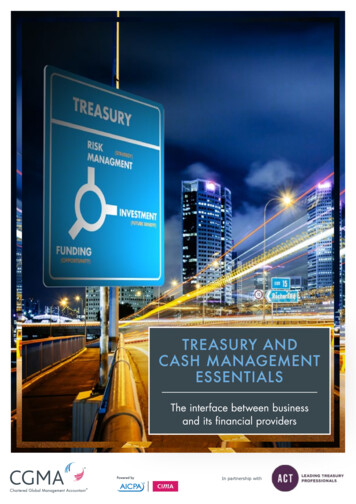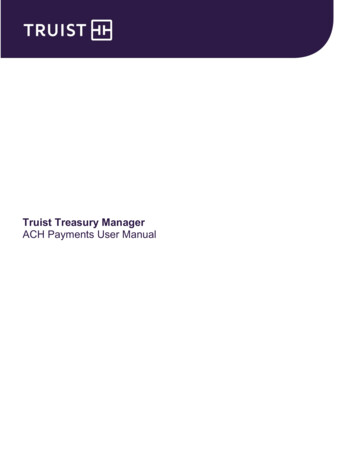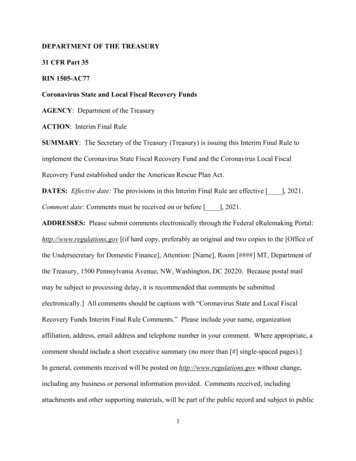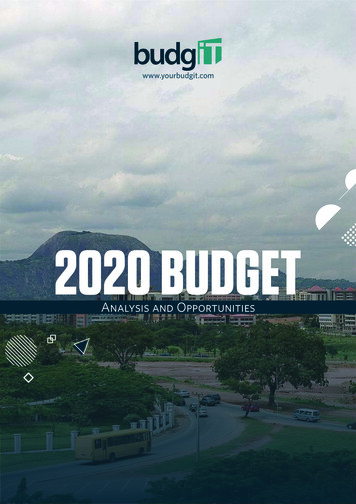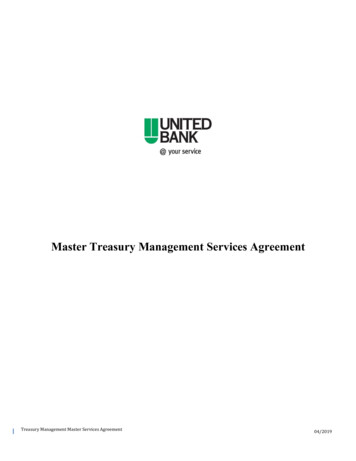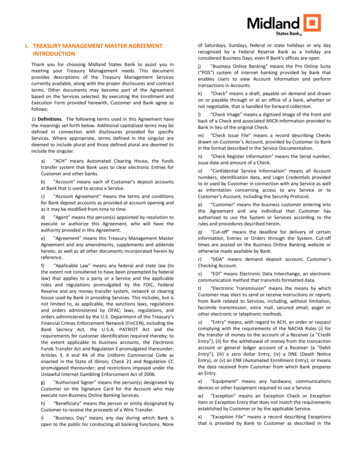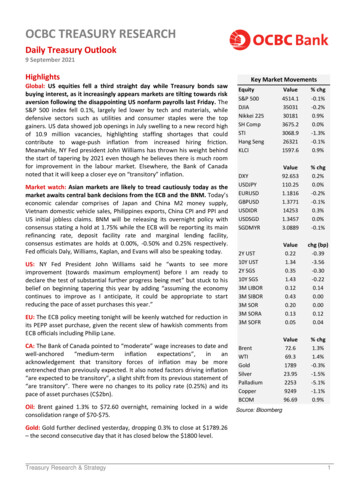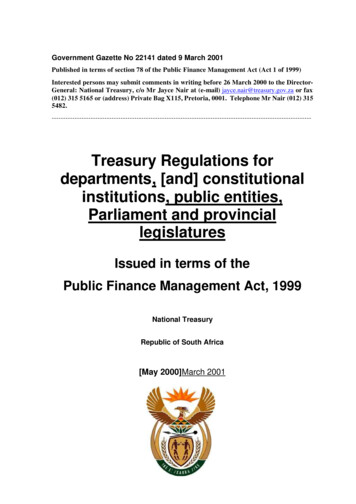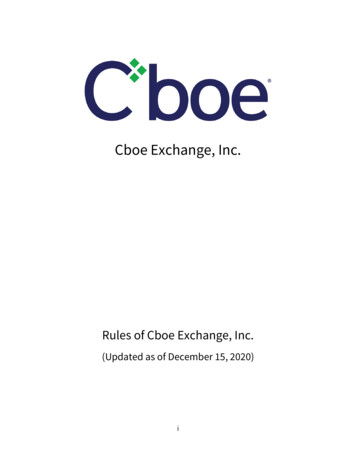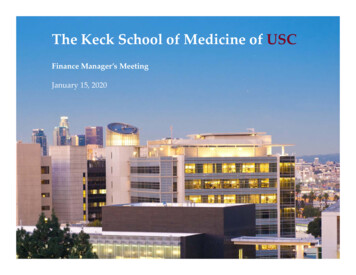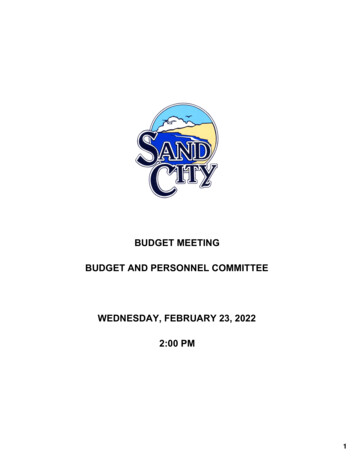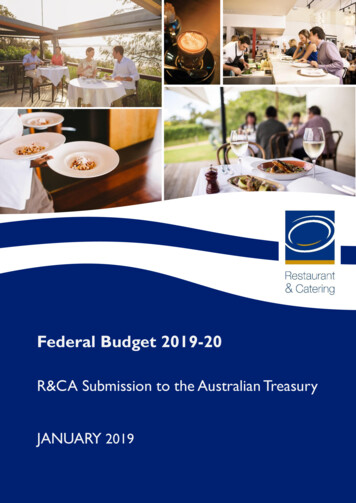
Transcription
Federal Budget 2019-20R&CA Submission to the Australian TreasuryJANUARY 2019
RESTAURANT & CATERING AUSTRALIARestaurant & Catering Australia (R&CA) is the national industry association representing the interestsof over 45,000 restaurants, cafes and catering businesses across Australia. R&CA delivers tangibleoutcomes to small businesses within the hospitality industry by influencing the policy decisions andregulations that impact the sector’s operating environment.R&CA is committed to ensuring the industry is recognised as one of excellence, professionalism,profitability and sustainability. This includes advocating the broader social and economiccontribution of the sector to industry and government stakeholders, as well as highlighting the valueof the restaurant experience to the public.Cover images courtesy of Tourism Australia
TABLE OF CONTENTSINTRODUCTION 1RECOMMENDATIONS 3INDUSTRY SNAPSHOT: CAFÉ, RESTAURANT AND CATERING SECTOR 5OVERVIEW OF KEY HOSPITALITY SECTOR TRENDS 6PROJECTED EMPLOYMENT GROWTH 6Figure 1: Top 20 industry sectors ranked by projected growth to May 2023 (‘000s) 6Figure 2: Employment growth projections to May 2023 – Accommodation and Food ServicesIndustry 7DEMAND AMONGST KEY HOSPITALITY SECTOR OCCUPATIONS 7Figure 3: Employment growth projections by hospitality occupation to May 2023 8CURRENT SKILL SHORTAGES 8Figure 4: Hospitality Businesses’ Difficulty in Filling Job Vacancies Compared to Last Financial Year 9DIFFICULTY IN FILLING KEY POSITIONS 9Figure 5: Hospitality Businesses’ Difficulty in Filling Key Occupations Over Past 12 Months 10TREASURY 11Extension of Instant ASSET Write-off Program 11Superannuation Guarantee 11Fringe Benefit Tax (FBT) 12FOREIGN AFFAIRS & TRADE 14Tourism Australia Funding 14IMMIGRATION AND BORDER PROTECTION 16Figure 6: Summary of Primary Visa Applications Lodged and Granted in 2016-17 and 2017-18 16Figure 7: Primary visas granted – top four occupations 17Visa Application Charges 17Skilling Australians Fund (SAF) LEVY 18Working Holiday Maker Visa 20Review of ANZSCO Codes 21ENVIRONMENT AND ENERGY 22Cost of Electricity and Gas 22Figure 8: Factors Making the Most Difference in Running a Business Successfully 23
EDUCATION 25National VET Marketing Campaign 25VET Student Loans Scheme 26Industry Specialist Mentoring for Australian Apprentices Program 26CONCLUSION 28REFERENCES 29
INTRODUCTIONAs the only national industry association representing the interests of over 45,000 cafés, restaurantsand catering businesses in Australia, R&CA is well-placed to provide feedback regarding the policysettings required at a Commonwealth Government level to ensure the continued viability andsuccess of the sector. The café, restaurant and catering sector is vitally important to the nationaleconomy, generating over 26.7 billion in retail turnover each year1 as well as employing 630,100people.2 Critically, over 92 per cent of businesses in the café, restaurant and catering sector are smallbusinesses, employing 19 people or less.3Given the importance of the café, restaurant and catering sector to the national tourism industry andto the Australian economy more generally, R&CA argues that the overarching policy settings at aCommonwealth Government level must be structured in such a way which supports rather thaninhibits the growth of the sector. In doing so, the Commonwealth Government would ensure thatthe broad spectrum of benefits associated with this growth will be maximised for the benefit of thethousands of business-owners and employees across the sector.R&CA’s biggest priorities in relation to the 2019-2020 Commonwealth Budget remain the areas ofskilled migration, taxation, vocational education and training (VET), as well as the small businessoperating environment more broadly. The forecast employment growth for the sector, generating anadditional 74,700 jobs by May 20234, presents several unique challenges including the intensifyingcrisis generated by skills shortages across vital hospitality positions such as cook, chef and café andrestaurant manager. In light of this problem, many of R&CA’s recommendations for the 2019-2020Commonwealth Budget are aimed at ameliorating the ongoing skills shortages problem inhibitingthe future growth of the sector.Whilst the skills shortage problem is particularly acute, this is not the only focus of the Associationin articulating its priorities for the 2019-2020 Commonwealth Budget. The policy settings affectingthe small business operating environment, including the structure of the fringe benefits tax program,1ABS (2018) 8501.0 - Retail Trade, Australia, Oct 2018.Department of Jobs and Small Business (2018) Employment projections for the five years to May 2023.3 ABS (2018) 8165.0 - Counts of Australian Businesses, including Entries and Exits, Jun 2013 to Jun 2017.4 Department of Jobs and Small Business (2018) Employment projections for the five years to May 2023.2Page 1
the reduction of electricity and gas prices and the continued operation of the instant asset write-offprogram, are also of significant interest to the Association.Page 2
RECOMMENDATIONS1. TREASURYa. INSTANT ASSET WRITE OFF PROGRAM Funding an extension of the instant asset write-off program until at least 30 June 2019 with aview towards making this program permanent and possibility expanding the eligibilityrequirements.b. SUPERANNUATION GUARANTEE Raise the Superannuation Guarantee Threshold to 750 per month ( 2,250 per quarter) andindex to CPI.c. FRINGE BENEFIT TAX Small businesses with an annual turnover less than 2 million should be exempt from payingFBT entirely under the Small Business Entity concessions.2. FOREIGN AFFAIRS & TRADEa. TOURISM AUSTRALIA Commit to increased funding for Tourism Australia in real terms over the forward estimates.3. IMMIGRATIONa. VISA FEES AND CHARGES Commit to a meaningful reduction in the cost of the TSS visa applications for both the shortterm and medium-term streams.b. WORKING HOLIDAY MAKER REFORM PACKAGE Reinstate the Commonwealth Government’s previous commitment to reduce the WorkingHoliday Maker visa fee to 390.c. SKILLING AUSTRALIANS FUND LEVY Halve the quantum of the existing SAF levy charged to sponsoring businesses for each visaapplication. Guarantee 1.5 billion investment in Skilling Australians Fund regardless of the amountgenerated through the levy.Page 3
Expand refund provisions associated with TSS-visa applications so that businesses arerefunded the SAF levy in the event of any unsuccessful applications, regardless of the reasonsinvolved. Non-upfront payment options for the SAF levy should be made available to employers whenprocessing applications.d. REVIEW OF ANZSCO CODES Commission the Australian Bureau of Statistics (ABS) to conduct a comprehensive and wideranging review of the existing Australian and New Zealand Standard Classification ofOccupations (ANZSCO) codes list with immediate effect.4. ENVIRONMENT AND ENERGYa. COST OF ELECTRICITY AND GAS The 2019-20 Commonwealth Budget include specific measures designed to reduce the costof electricity and gas prices. That no new taxes, levies or charges that increase the cost of electricity or gas are included inthe 2019-20 Budget.5. EDUCATION & TRAININGa. NATIONAL VET MARKETING CAMPAIGN A sophisticated and wide-reaching national marketing campaign targeting increasedenrolments and completions of VET sector courses should be funded by the CommonwealthGovernment, with a minimum investment of 10 million.b. VET STUDENT LOAN SCHEME Reinstate the Diploma and Advanced Diploma of Hospitality on the approved course list atband 10,000 or 15,000 as part of the VET Student Loan scheme.c. INDUSTRY SPECIALIST MENTORING FOR AUSTRALIAN APPRENTICES Funding for the Industry Specialist Mentoring for Australian Apprentices program for industryspecific mentoring should be extended for an additional two years as part of the 2019-20Commonwealth Budget.Page 4
INDUSTRY SNAPSHOT: CAFÉ, RESTAURANT AND CATERING SECTORTHE SECTOR CONTRIBUTES 45.3 BILLION TO THENATIONAL ECONOMYTAKEAWAY COMPONENT, 18.6 BILLION 45.3 BillionEXPENDITURE ONRESTAURANT ANDTAKEAWAY MEALS IN2016-17 ACCOUNTEDFOR 16 CENTS OUT OFEVERY TOURISTDOLLARTHE SECTOREMPLOYS 630,100 PEOPLEEXPECTED TO REACH 704,800 BY MAY 2023.45,092CAFÉS, RESTAURANTS &CATERING BUSINESSES INAUSTRALIA92.1% ARE SMALL BUSINESSESPage 5EMPLOYMENT GROWTH ISPROJECTED AT 11.9% OR74,700 JOBS BY MAY 2023THIS RATE OF GROWTH IS HIGHERTHAN ANY OTHER INDUSTRYSUBSECTOR IN THE AUSTRALIANECONOMY.
OVERVIEW OF KEY HOSPITALITY SECTOR TRENDSPROJECTED EMPLOYMENT GROWTHBased on the current projections, the hospitality sector is expected to account for an increasingproportion of jobs growth in the Australian workforce over the coming five years. According to themost recently published employment projections from the Department of Jobs and Small Business,the cafe, restaurant and takeaway food subsector is expected to generate an additional 74,700workers by May 20235. When expressed in terms of percentage growth, the sector is expected toexperience employment growth of 11.9 per cent.6 Most significantly, the projected growth for thecafé, restaurant and takeaway food sector is larger than any other industry subsector. The projectedemployment growth associated with the café, restaurant and takeaway food sector vis-à-vis otherindustry subsectors is demonstrated in Figure 1 below.Figure 1: Top 20 industry sectors ranked by projected growth to May 2023 (‘000s)Source: Department of Jobs and Small Business (2018) Employment projections for the five years to May 2023.56Department of Jobs and Small Business (2018) Employment projections for the five years to May 2023.Ibid.Page 6
Figure 2: Employment growth projections to May 2023 – Accommodation and Food Services IndustrySource: Department of Jobs and Small Business (2018) Occupation Projections to May 2023.DEMAND AMONGST KEY HOSPITALITY SECTOR OCCUPATIONSWhen analysing the projected jobs growth across the café, restaurant and catering sector, it isapparent that several key occupations will account for a significant proportion of overall positions.Figures published by the Department of Jobs and Small Business included in Figure 2 below showthat projected growth in the number of cooks, chefs and café and restaurant managers is expectedto collectively generate an estimated 28,500 new positions in the next five years.7 Significantly, allthree positions are projected to experience double-digit percentage growth over the five year periodto May 2023, with 16.7 per cent growth in the number of chefs, 13.9 per cent growth in the numberof café and restaurant managers and 13.6 per cent growth in the number of cooks.8 Whenrepresented as a percentage of the total jobs growth in the café, restaurant and takeaway food sectorover the same period, these three occupations account for 38.2 per cent of all positions.78Ibid.Ibid.Page 7
Figure 3: Employment growth projections by hospitality occupation to May 2023Department of Employment ProjectionsEmploymentlevel May 2018(‘000)Projected employmentlevel May 2023 (‘000)Cooks45.53513Chefs1411Cafe and Restaurant ManagersUnit GroupCodeOccupation3514Projected employment growthfive years to May .09.713.9Source: Department of Jobs and Small Business (2018) Occupation Projections to May 2023.CURRENT SKILL SHORTAGESThe significant jobs growth associated with the hospitality sector over the next five years and growingdemand amongst employers in filling vacancies amongst key positions has magnified the effect ofexisting skills shortages. In the absence of significant government intervention, R&CA anticipates thatskills shortages amongst key hospitality occupations will continue to deteriorate, putting the fullspectrum of economic benefits associated with the sector’s persistent growth at risk. R&CA thereforeurges the Commonwealth Government to implement a set of favourable policy settings aimed atreversing this worrying trend.Evidence collected from R&CA’s member businesses has shown a steadily increasing level of difficultyin recruiting for job vacancies within their businesses over the past 3 years. According to data fromR&CA’s 2018 Industry Benchmarking Report, 47.3 per cent of business-owners reported experiencing‘some’ difficulties in filling positions, compared to 34.8 per cent in 2016 and 40.5 per cent in 2017.9 Anadditional 27.3 per cent of respondents also reported experiencing ‘extreme’ difficulties in filling staffvacancies.10 In total, almost three-quarters (74.6 per cent) of business-owners experienced eithersome or extreme difficulty in filling job vacancies. R&CA would anticipate this number to increase inthe 2019 survey as skills shortages affecting the sector continues to intensify. A breakdown of the datacollected in R&CA’s 2018 Industry Benchmarking Report overviewing employers’ recruitmentdifficulties is contained in Figure 4 overleaf.9Restaurant & Catering Australia (2018) 2018 Industry Benchmarking Report, p.21.Ibid.10Page 8
Figure 4: Hospitality Businesses’ Difficulty in Filling Job Vacancies Compared to Last Financial YearSource: Restaurant & Catering Australia 2018 Industry Benchmarking Report, p.22.DIFFICULTY IN FILLING KEY POSITIONSThe nature of the current skills shortage crisis affecting the hospitality industry is especiallyproblematic for business-owners, as the shortages are most acute amongst the highly skilledoccupations of cooks, chefs and café and restaurant managers. As is the case amongst all vacanciesin the hospitality sector, the difficulty associated with recruiting for each of these skilled positionshas increased dramatically in recent years.R&CA’s 2018 Industry Benchmarking Report indicated that the most difficult position to fill over the2016-17 financial year was chef with almost half of all operators (48.2 per cent) reporting that fillingchef vacancies in their businesses was ‘very difficult’.11 A further 21.3 per cent of operators statedthat they had experienced some difficulty in recruiting for chefs.12 Café or restaurant managervacancies were also amongst the most significantly difficult vacancies to fill with 41.1 per cent ofsurvey respondents reporting extreme difficulty and a further 15 per cent reporting some difficulty.13Finally, the position of cook also saw 23.3 per cent of operators experience extreme difficulties infilling vacancies with 35.2 per cent reporting some difficulty.14 A complete breakdown of all11Ibid.Ibid.13 Ibid.14 Ibid.12Page 9
hospitality positions and the corresponding level of difficulty in filling vacancies amongst thosepositions is represented in Figure 5 below. Given the importance of these positions in fillingvacancies, R&CA strongly urges the Commonwealth Government to address these difficultiesthrough targeted investment in skills, training and immigration programs as part of the 2019-20Budget.Figure 5: Hospitality Businesses’ Difficulty in Filling Key Occupations Over Past 12 MonthsSource: R&CA 2018 Benchmarking Report, p.23.Page 10
1. TREASURYA. EXTENSION OF INSTANT ASSET WRITE-OFF PROGRAMSince its inception as part of the 2015-2016 Commonwealth Budget, the Instant Asset Write-OffProgram has enjoying significant popularity amongst small-business owners, particularly amongstthe café, restaurant and catering sector. In each of the subsequent Commonwealth Budgets deliveredsince the program was first announced, it has been extended by an additional 12 months with thecurrent program set to expire as of 30 June 2018. R&CA argues that this program allowing smallbusinesses with an annual turnover of up to 10 million to immediately deduct eligible assets eachcosting less than 20,000 should be extended for an additional 12 months until 30 June 2019 as partof the provisions contained in the 2019-2020 Budget.Whilst a 12-month extension of the program would be a welcome measure, R&CA believes that asufficient amount of time has elapsed to warrant closer inspection of the program. Given that theprogram has been extended for several financial years, R&CA believes that it would be an appropriatestep to convert this program to a permanent measure to give small business-owners certainty eachfinancial year, rather than having to wait until confirmation is provided from the CommonwealthGovernment at a Budget time. In addition, R&CA also believes that the eligibly requirements for thisprogram could also be relaxed by expanding the turnover threshold from 10 million to 20 millionso that more businesses are able to access it.Recommendation Funding an extension of the instant asset write-off program until at least 30 June 2019 witha view towards making this program permanent and possibility expanding the eligibilityrequirements.B. SUPERANNUATION GUARANTEEThe Superannuation Guarantee (SG) threshold was established in 1996 at 450 per month at a timewhen the minimum wage was 9.19 per hour. However, under the Restaurant Industry Award 2010,the current SG threshold is 350 per month. Today the minimum wage under this Award is 18.29per hour (at an introductory level) which is nearly double what it was 1996.15 Despite this growth,15Fair Work Ombudsman (2017) Pay Guide - Restaurant Industry Award 2010 [MA000119], 2 August.Page 11
the SG threshold has remained the same. Based on the growth in the minimum wage over the lasttwo decades, the SG threshold should be set at approximately 750 per month or 2,250 per quarter.The failure of the SG threshold to keep up with the persistent increases to the minimum wage overthe last two decades represents a significant imposition on both small and large businesses alike. Forhospitality operators, this represents in an increased in the costs associated with employing staffwithout any corresponding increase in productivity to offset this increase. The rising costs involvedin employing staff are reflected in R&CA’s 2018 Industry Benchmarking Report which found that, onaverage, 48.1 per cent of a typical hospitality business’ total expenditure was related to employingstaff including staff training and on-costs, an increase from the previous financial year.16 Given thesesignificant pressures, R&CA recommends that the SG threshold be raised to 750 per month or 2,250 per quarter and that it be indexed to CPI.Recommendation Raise the Superannuation Guarantee Threshold to 750 per month or 2,250 per quarterand index to CPI.C. FRINGE BENEFIT TAX (FBT)R&CA has long advocated for changes to the Fringe Benefits Tax (FBT) system, recognising thecompliance cost to small businesses is proportionately higher than for large corporations. Thisargument has centred on the inequity that exists in the ability of small businesses to employstrategies to avoid FBT compared to big business. For instance, large, well-resourced corporationscan employ FBT-avoidance strategies such as having boardroom catering or “in-house” meals ratherthan ordering meals from a café or restaurant. Small businesses simply do not have the resources toadopt the same kind of FBT-avoidance strategies of larger businesses, contributing to the inherentunfairness of this system.The hospitality sector is further affected by the FBT system due to the treatment of restaurant mealsas employee fringe benefits, as opposed to a legitimate form of doing business. R&CA argues thathaving meals which are genuinely for business purposes attract FBT unfairly penalises hospitality16Restaurant & Catering Australia (2018) Industry Benchmarking Report.Page 12
operators and small café and restaurant businesses. Classifying meals purchased from cafés andrestaurants as a legitimate form of business would also have the effect of stimulating increasedeconomic activity at restaurants and cafés and further contribute to the jobs growth associated withthis sector.Based on the compliance cost and lack of access to strategies to minimise the burden of FBT, R&CAargues that small businesses should be exempt entirely from FBT under the Small Business Entityconcessions. Small businesses with a turnover of less than 2 million currently receive concessionson FBT for car parking.17 R&CA contends that these concessions should be extended to include allFBT.Recommendation Small businesses with an annual turnover less than 2 million should be exempt from payingFBT entirely under the Small Business Entity concessions.17Australian Taxation Office (ATO) (2017) FBT concessions, 22 May.Page 13
2. FOREIGN AFFAIRS & TRADEA. TOURISM AUSTRALIA FUNDINGR&CA has long been an advocate of the important role played by Tourism Australia in promotingAustralia as a highly desirable destination for international tourists from critical overseas marketssuch as China, India, the United States and United Kingdom. Past campaigns from Tourism Australiaincluding the Restaurant Australia campaign, which contributed to a 12.6 per cent increase in foodand wine spend by international visitors ( 4.7 billion in total expenditure)18, have resulted inconsiderable success in terms of boosting Australia’s international reputation. In order to ensure thatTourism Australia is in a viable position to continue its successful tourism marketing efforts, accessto funding from Commonwealth Government channels is vital.The inherent value of Australia’s international tourism sector is evidenced by the latest statisticspublished in January 2019 from Tourism Research Australia’s International Visitor Survey (IVS). Thisdata showed that Australia attracted a total of 8.4 million international visitors with expenditure of 43.2 billion across all categories for the YE September 2018, representing visitor growth of 6 percent and expenditure growth of 5 per cent.19 The IVS data also indicated that international touristsspent almost 13 billion ( 12.9 billion) on food, drink and accommodation costs in the 12 months toSeptember 2018.20 Compared to the previous 12-month period, this represented an increase from 12.5 billion dollars or 3.2 per cent when represented in percentage terms. Food, drink andaccommodation also represented the biggest expenditure category overall followed by pre-paidinternational airfares.21R&CA attributes much of the success of Australia’s international tourism market to promotionalcampaigns from Tourism Australia such as those seen recently with Undiscover Australia andDundee.22 Given the strong performance of the tourism sector and its contribution to the Australianeconomy, R&CA urges the Commonwealth Government to commit to increased funding for TourismAustralia in real terms over the forward estimates. R&CA urges that the tourism portfolio should not18Tourism Australia (2015) Restaurant Australia Results.19Ibid.20 Tourism Research Australia (2019) Latest International Visitor Survey (IVS) Results – Year Ending September 2018, 9 January 2019.21 Ibid.22Australian Government (2019) Minister for Trade, Tourism and Investment, Tourism spending soaring as travellers head to theregions, Media Release, 9 January.Page 14
be short-changed in terms of funding as part of the 2019-2020 Budget as was the case in the 201718 Budget. In R&CA’s view, the tourism marketing functions of Tourism Australia are a critical aspectof ensuring the ongoing economic vitality and prosperity of one of Australia’s most importantindustries and should therefore be a priority of the 2019-2020 Budget.Recommendation Page 15Commit to increased funding for Tourism Australia in real terms over the forward estimates.
3. IMMIGRATION AND BORDER PROTECTIONR&CA is greatly concerned at recent evidence showing a significant decline in the number of skilledvisas both in terms of those lodged as well as those granted. This decline has been particularly acutesince the implementation of the Temporary Skills Shortage (TSS) which was first announced in April2017 and commenced in March 2018. According to the most recently available statistics publishedby the Department of Home Affairs, as of 30 June 2018, the size of the overall TSS (and residualsubclass 457 visa) program has substantially decreased when compared to previous period in 201617.23 When comparing the lodgement of primary visa applications over the two-year period, therehas been a total decline of 28.4 per cent, with 54,820 applications received in 2016-17 compared to39,230 in 2017-18.24 The number of applications granted also declined from 46,480 in 2016-17 to34,450 in 2017-18.25 These trends illustrating the decline in skilled visa applications, both lodged andprocessed, can be seen in Figure 6 below.Figure 6: Summary of Primary Visa Applications Lodged and Granted in 2016-17 and 2017-182016-17 at2017-18 at% difference30/06/1730/06/18Primary applications lodged54,82039,230-28.4%Primary applications granted46,48034,450-25.9%Number of primary visa holders in90,59083,470- 7.9 %AustraliaSource: Department of Home Affairs (2018) Temporary resident (skilled) report 30 June 2018 - summary of key statistics and trends.R&CA is also concerned that a significant proportion of this decline in visa applications andsubsequently those approved has occurred amongst key hospitality sector occupations. For instance,amongst the occupation of cook, there has been a 37.9 per cent reduction in the number of primaryvisas granted in 2017-18 compared to those in 2016-17.26 R&CA believes that this decline isattributable to the failure to include cook as an occupation on the MLTSSL, with visa applicantsinstead applying for the occupation of chef which has been included in the MLTSSL, thus providing apathway to permanent residency. R&CA also argues that the significant increases in the costs23Department of Home Affairs (2018) Temporary resident (skilled) report 30 June 2018 - summary of key statistics and trends.Ibid.25 Ibid.26 Ibid.24Page 16
associated with the current skilled visa system, particularly those associated with the SkillingAustralians Fund levy have created a powerful disincentive for visa-seekers and sponsoringemployers for these hospitality positions. The significant reduction in overseas skilled migrants inpositions such as chefs has further compounded the skills shortage problem affecting the hospitalityindustry.Figure 7: Primary visas granted – top four CT BusinessAnalystUniversityLecturerCook2016-17 to30/06/20172017-18 to30/06/20182,1201,640% Difference from lastprogram year as at30/06/2017-22.4%2017-18 as % oftotal 1,350-37.9%3.9%4.8%Source: Department of Home Affairs (2018) Temporary resident (skilled) report 30 June 2018 - summary of key statistics and trends.A. VISA APPLICATION CHARGESAs R&CA has previously mentioned in this submission, the hospitality sector is heavily reliant on theskilled migration system to source the skilled labour required to operate businesses successfully,particularly in comparison to other industry sectors. R&CA has strongly advocated that the structureof Australia’s skilled migration system should be designed in such a way that supports thoseindustries expected to contribute the most to future employment outcomes. To achieve this, it isimperative for the Commonwealth Government to ensure that the cost of the skilled visas, includingthe Temporary Skills Shortage (TSS) visa, are international competitive. R&CA explicitly made thisrecommendation as part of the Department of Home Affairs’ (then known as the Department ofImmigration and Border Protection) Review into visa simplification in September 2017.Under the current pricing arrangements, the cost of a TSS visa (Subclass 482) is 1,175.00 AUD foroccupations listed on the Short-term Skilled Occupation List (STSOL) and 2,455.00 AUD per visa foroccupations listed on the Medium and Long-term Strategic Skills List (MLTSSL).27 The current costsof the TSS-visas under the short-term and medium to long term streams represent significantincreases compared to the previous 457-visa system. R&CA believes that the current pricing of the27Department of Home Affairs (2018) Visa Pricing Estimator, -estimatorPage 17
TSS visa acts as a disincentive for potential skilled migrants and should be subject to a meaningfulreduction to
VET STUDENT LOAN S HEME Reinstate the Diploma and Advaned Diploma of Hospitality on the approved ourse list at and 10,000 or 15,000 as part of the VET Student Loan sheme. . INDUSTRY SNAPSHOT: CAFÉ, RESTAURANT AND CATERING SECTOR THE SECTOR EMPLOYS 630,100 PEOPLE EXPECTED TO REACH 704,800 BY MAY 2023. THE SECTOR CONTRIBUTES
